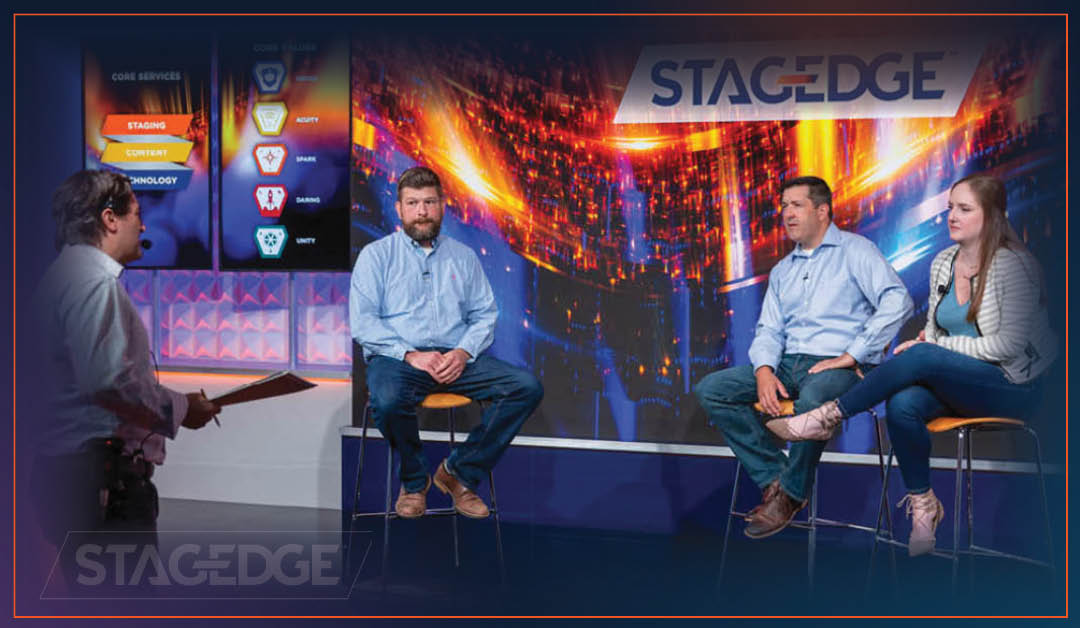A Day in the Life of Director of Video Production Jason Kershner
 Ever since he was old enough to pick up a camera, Jason Kershner, director of video production at Stagedge, has loved captivating audiences. As a full-service event and video-production company, Stagedge values innovative storytelling, which is why Kershner felt right at home from the start. In this revealing Q&A, Kershner recounts his origins, his work at Stagedge, and the excitement that comes from helping clients tell their stories.
Ever since he was old enough to pick up a camera, Jason Kershner, director of video production at Stagedge, has loved captivating audiences. As a full-service event and video-production company, Stagedge values innovative storytelling, which is why Kershner felt right at home from the start. In this revealing Q&A, Kershner recounts his origins, his work at Stagedge, and the excitement that comes from helping clients tell their stories.
Q: What’s a project that you worked on recently that you really enjoyed?
JK: There are so many!
We recently produced a large event for a global client, which presented a great opportunity for wrap-around coverage with daily pre-event and post-event studio shows as well as specialty on-demand content for people to watch after the conference. We produced this content with an on-site studio just like a TV network would cover a live event. Likening it to a sporting event,  we produced a pre-game show before the general session each day, introducing the day’s highlights and important information, plus exclusive executive and specialty interviews that otherwise might not have been captured. We also produced a post-session show that recapped key messages, featured interviews with presenters, and previewed the upcoming day. Live, seamless transitions between every component and the studio show kept viewers engaged—an exciting broadcast-style element for the client.
we produced a pre-game show before the general session each day, introducing the day’s highlights and important information, plus exclusive executive and specialty interviews that otherwise might not have been captured. We also produced a post-session show that recapped key messages, featured interviews with presenters, and previewed the upcoming day. Live, seamless transitions between every component and the studio show kept viewers engaged—an exciting broadcast-style element for the client.
Q: What’s something about your job that might happily surprise people?
JK: Clients appreciate our attention to detail in learning about their brand and how best to tell their story. We proactively research technology and introduce it only with purpose—never tech for tech’s sake.
There’s a process to telling a good story. Knowing how and when to integrate tech and innovation is a skill. Often, clients say, “We had no idea this technology existed.” We make sure every project delivers ROI while exceeding expectations.

Q: In the past decade, Video has become an increasingly important part of the way we communicate. How has that changed your work, and how do you see the role of video evolving?
JK: Video must be accessible and efficiently produced. With so many viewing choices, content needs versatility and longevity across platforms. We track trends—retention rates, interactive elements, and platform shifts. Video’s importance will only grow; there’s always a new channel, so we build that foresight into every project.
Q: What upcoming trends are you excited about? Are there trends you would steer clients away from?
JK: Interactive motion graphics and animation make videos engaging and let presenters or viewers trigger visual elements. VR/AR that audiences can activate themselves creates amazing experiences.
AI is exciting, but we’re cautious: it must be integrated purposefully and ethically. The AI video landscape is just beginning, so we advise clients to do due diligence.
Q: What advice would you give someone starting a career in video or events?
JK: Education matters—whether formal study or hands-on learning. Analyze the videos you love, then get experience. Connect with professionals and join creative communities. Anyone can film a video now, but few do it well. Stagedge’s experienced technicians and pro-grade tech make our content stand out.
Interested in integrating professional-grade technology into your next event or video production? Learn how Stagedge transformed ADI’s live event into a unique virtual experience rich with immersive broadcasting and on-demand training—or reach out to us to learn more.
Stagedge: Elevating Event-Production Experiences for 50 years, we’re proud to be one of Boston’s premier full-service event-production companies, conceiving, creating, and executing immersive brand experiences through live, virtual, and hybrid events worldwide.
